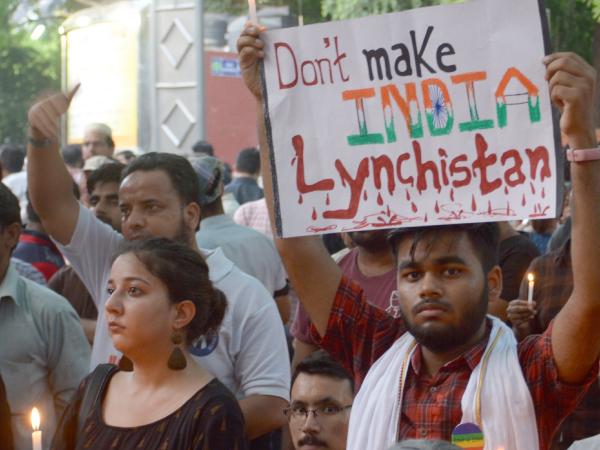Tarique Anwar, TwoCircles.net
The rising tide of mob violence in India, particularly against Muslims, has shattered the illusion of safety and justice. What was once sporadic has now become systemic, with lynchings and targeted harassment occurring across the country. These incidents, fueled by hate and emboldened by state inaction, paint a grim picture of modern India — where communal violence is normalised and justice remains elusive.
On March 3, Muslims leaving a mosque in Ahmedabad’s Vatva area after Taraweeh prayers were reportedly waylaid by a Hindutva mob. Armed with knives, the assailants forced them to chant ‘Jai Shri Ram’ (a Hindu religious slogan) at knifepoint.
Stones were allegedly hurled on them from rooftops, injuring at least three people, including a 17-year-old. When the survivors attempted to file a police complaint, the First Information Report (FIR) was registered against “unknown persons”, shielding the attackers.
On March 5, Salim Mewati and Aquib Mewati were publicly beaten and paraded by the police at Ghattia in Madhya Pradesh’s Ujjain district.
Accused of cow slaughter, they were forced to chant: “Gai hamari mata hai, police hamara baap hai” (The cow is our mother, the police our father).
On a train in Gujarat’s Ankleshwar, an elderly cleric was brutally beaten up. He had gone to the state for collecting donations for his mosque in Rajasthan’s Ganga Nagar. Accused of touching a woman — a charge the woman’s family vehemently denies — he was labeled a “Pakistani” before being attacked.
In another incident, an elderly man reciting the Quran on a train faced a similar fate.
In Navi Mumbai, Muslim moviegoers were humiliated and forced to prostrate before a group of Maratha men who accused them of laughing during a film screening.
Post 2024 election incidents
After the results of the 2024 general elections, hope for a decline in religiously motivated violence quickly faded. Instead, a wave of attacks sent a clear message — Hindutva extremists remained emboldened under Modi’s third term.
On June 7, last year, a Hindu right-wing mob reportedly lynched two Muslim men in Chhattisgarh’s Raipur over alleged cattle smuggling. A third victim succumbed to injuries days later.
On June 18, a Muslim man in Uttar Pradesh’s Aligarh was allegedly beaten to death by a mob. A video surfaced showing men wielding sticks cornering and brutalising him. Shockingly, local Bharatiya Janata Party (BJP) officials openly supported the attackers.
On June 22, a 23-year-old Muslim man was allegedly killed by a mob during a cricket match in Gujarat’s Ahmedabad. The tensions had begun before the game, as the presence of Muslim players “disturbed” some Hindutva supporters.
On June 24, Hindu extremists in Chhattisgarh’s Dantewada district allegedly murdered a woman on the charges of “converting” people to Christianity.
On June 30, a Muslim cleric was allegedly lynched after being accused of hitting a woman in Jharkhand.
State-backed persecution?
Systematic oppression continues beyond lynchings. In Uttar Pradesh, authorities ordered eateries along a Hindu pilgrimage route to display the names of their owners, effectively segregating Muslim-owned businesses. Critics compared this to apartheid, warning of economic boycotts.
Meanwhile, the Modi government has proposed changes to the Waqf Act, seeking to diminish Muslim authority over Islamic endowments by ensuring non-Muslim representation in waqf boards. Lok Sabha MP Asaduddin Owaisi, chief of Hyderabad-based All India Muslim Majlis-e-Ittehadul Muslimeen (AIMIM), and the Congress-led Opposition in the Lower House of Parliament condemned the bill as a direct attack on Muslim institutions.
Fear normalised
In Himachal Pradesh, a Muslim businessman allegedly faced mob violence after being falsely accused of cow slaughter. His shop was vandalised, and at least 16 other Muslim shopkeepers were forced to flee the town. The mob, chanting “shoot the traitors”, was not held accountable.
Despite widespread violence, the Opposition has remained largely silent. The Congress, which received overwhelming Muslim support in the elections, has failed to make Muslim persecution a core issue.
Meanwhile, the BJP continues to thrive on majoritarian politics, allegedly stoking communal tensions to solidify its voter base.
Owaisi put it bluntly: “Muslims are often spoken about, discussed and debated — but they are never heard.”
A nation on the brink
What we are witnessing is not random violence but a deliberate campaign to marginalise, dehumanise and terrorise an entire community. As long as the state remains complicit and justice remains elusive, lynchings will continue to define India’s social fabric.
For now, the question remains: how many more lives must be lost before India wakes up?


